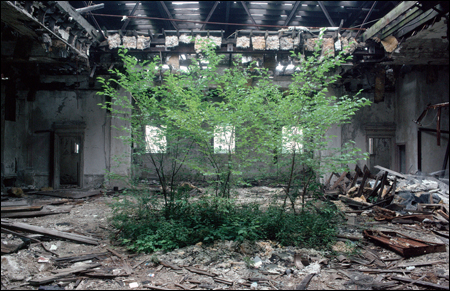Conference builds on ‘the built environment’
Area of study in search of its identity at Warren Center

The conference title was “Reconceptualizing the History of the Built Environment in North America.”
The subtitle might have been “Notes from a Field in Search of Itself.”
The meeting, presented April 29-30 by Harvard’s Charles Warren Center for Studies in American History, brought together around 100 participants, mostly scholars in the fields of history, architecture, architectural history, geography, and American studies.
The built environment is an emerging area of study that Lizabeth Cohen of Harvard’s History Department, one of the chairs of the conference, called “not a discipline but a meeting ground.”
One of the threads running through the discussions, which were held at Gund Hall, was the challenge that built environment studies faces in finding an intellectual home on today’s university campuses. “The field runs the risk of becoming too diffuse,” observed Martha McNamara, associate professor of history at the University of Maine and one of this year’s Warren Center fellows.
On the other hand, some at the conference clearly saw opportunity in the fact that the boundaries have not yet been as sharply delineated as in other fields of study.
Daniel M. Abramson, associate professor of art history at Tufts University, described his own field, architectural history, as “homeless,” marginalized in departments of architecture, and in not quite the right place in departments of art history. And yet, he suggested, architectural history has an important role as “first among equals” in built environment studies, especially in connection with the broader field of history. “What can architectural history teach history that history can’t learn on its own?” he asked.
Conference presenters were encouraged to discuss the methodologies they used in their research. And so another thread running through the conference was the tension between reading and seeing – between text-based history, on the one hand, and history grounded in actual visual study of buildings and streetscapes, on the other. As Robin Bachin, a historian at the University of Miami, noted, “Historians tend to privilege written text, but they’re becoming more sensitive.”
Anne Whiston Spirn, professor of landscape architecture and planning at the Massachusetts Institute of Technology, stressed the importance of images not just as representations but as “tools of discovery,” and added, “Seeing is a way of knowing, and drawing and photographing are ways of thinking.”
In his presentation at the keynote session, Robert Fishman, professor of urban planning at the University of Michigan, stressed the contribution of the design professions in helping urban history confront perhaps its biggest issue, the postwar crisis of America’s big cities.
“The urban crisis has taken urban history from its older alliance with sociology to new partnerships with architecture, planning, urban design, and historic preservation…. Urban historians drew on the visual expertise of the design professions. Urban history learned how to see.”
Dianne Harris of the University of Illinois, Urbana-Champaign, has been doing some looking herself, and she presented some of what she has seen in a paper titled “Little White Houses: Critical Race Theory and Interpretation of Ordinary Dwellings in the United States, 1945-60.” She concludes from her research, in shelter magazines and in studies of the “built record” of actual houses, that these suburban tract homes reinforced “whiteness” as a social construct. The very spaces and objects of these new houses, moreover, “coached immigrants” into a new status as (white) Americans, she said. She cited the example of her own grandmother, a German Jewish immigrant in postwar suburban Los Angeles, whose new kitchen had a built-in pancake griddle – which she used to make latkes.
Historians of the built environment are also learning how to listen, it would seem from a presentation by Jeffrey Melnick, associate professor of American studies at Babson College in Wellesley. His presentation, “Project Culture: The Popular Arts of Public Housing,” invited his listeners to consider how public housing projects in New York, Chicago, and Detroit have “hosted a musical conversation” that has been a major force in popular music for decades.
He contended that the very same concrete architecture widely seen as a cause of crime in “the projects” has also given rise to music: The superb acoustics of their stairwells and bathrooms has made them great rehearsal spaces for budding musicians, from the pioneers of doo-wop on through to today’s hip-hop artists. “How can we begin to understand and honor the cultural work of the housing projects?” Melnick asked.
The conference was supported by the Radcliffe Institute for Advanced Study, the Graduate School of Design, and the A. Alfred Taubman Center for State and Local Government at the Kennedy School of Government.




